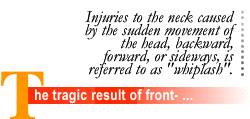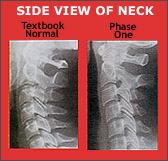
|
 |
head is suddenly jerked back and forth beyond its normal limits, the muscles and ligaments supporting the spine and head can be overstretched or torn. The soft, pulpy discs between spinal bones can bulge, tear or rupture. Vertebrae can be forced out of their normal position, reducing range of motion. The spinal cord and nerve roots in the neck can get stretched and irritated. While the occupants can suffer considerable soft tissue injury, the car may be only slightly damaged.
The resulting instability of the spine and soft tissues can result in headaches, dizziness, blurred vision, pain in the shoulder, arms and hands, reduced ability to turn and bend, and even low back problems. As the body attempts to adapt, symptoms may not appear for weeks or even months later.
The chiropractic approach to these types of injuries is to use specific chiropractic adjustments to help return spinal function. After a thorough case history and examination, the doctor will recommend a series of visits to help restore proper motion and position of spinal bones. If caught early enough, inflammation can be reduced and scar tissue can often be minimized.
Consult a Doctor of Chiropractic before enduring constant headaches, depending upon addictive pain medication, or submitting to surgery!

A continuing schedule of regular chiropractic checkups can help detect, correct, and maintain optimum spinal and nervous system function. Find out how chiropractic care, combined with proper diet, exercise, and other aspects of good health and personal hygiene can enhance your well-being and help you enjoy life to the fullest. Ask your Doctor of Chiropractic for a care program designed for your age, condition, and lifestyle.
· REFERENCES ·
Liberti, F., D.C., Can a Passenger Be Injured If the Car is Not?, Medical/Legal Consultants Associates, 1994.
Farbmann, AA: Neck Sprain, JAMA, 223(9):1010-1015, 1973.
Coffee, M.S., Edwards, W.T., Hayes, W.C., and White. Hyperextension Injury Patterns in the Human Cadaveric Cervical Spine [Abstr.], Cervical Spine Research Society, 1989.
Green, J.D., Harle, T.S., Harris J.H., Jr., Anterior Subluxation of the Cervical Spine: Hyperflexion Sprain, AJNR 2:243-250, 1981.
MacNab, I., Acceleration Extension Injuries of the Cervical Spine, Rothman, M.D., Simone, M.D., (eds): The Spine, edition 2, Philadelphia, W.B. Saunders, Vol. 2, 1982.
White, A., Panjabi, M., Clinical Biomechanics of the Spine, 2nd edition, J.B. Lippincott Company, 1990.
Burn, L., A Manual of Medical Manipulation, Kluwer Academic Publishers, 1994.
Bocchi, L., Orso, Whiplash Injuries of the Cervical Spine, South Ital ORTHOP Traumatal Supp:171-181, November 9, 1983.
Foreman, S., Croft, A., Whiplash Injuries: The Cervical Acceleration/Deceleration Syndrome, Williams and Wilkins, 2nd edition, 1995.
Torola, G.A., Whiplash: General Considerations, Assessment, Treatment, Management, and Prognosis-Part 1, ACA Journal of Chiropractic, 30(1):63-70, 1993.
Yochum, T., D.C., Rowe, T., D.C., Essentials of Skeletal Radiology, Volume 1, Williams and Wilkins, 1987.
Cailliet, Rene, M.D., Neck and Arm Pain, F.A. Davis Co., 1977.
Gay, J., M.D., Abbott, K., M.D., Common Whiplash Injuries of the Neck, JAMA, pp. 1698-1704, August 29, 1953.
© 1999 Back Talk Systems, Inc.



Leave A Comment
You must be logged in to post a comment.